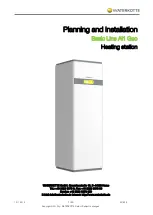
mechanical wear. If any of these conditions exist, replace
the magnetic contactor. HOTSTART recommends
contactors be replaced every five years.
4.2.5 PUMP SEAL
If seal becomes worn, replacement pump seals are
available. To ensure pump seal longevity, ensure
the supply lines do not restrict flow excessively (
see
SECTION 2.1.1
and
).
NOTE:
Instructions to replace the pump seals are
included with replacement seals.
4.2.6 CONTROL THERMOSTAT
WARNING
!
Hazardous voltage:
Before wiring, servicing or cleaning
the heating system, turn off the power and follow your
organization’s lockout and tagout procedure. Failure
to do so could allow others to turn on the power
unexpectedly, resulting in harmful or fatal electrical
shock.
To replace the control thermostat sensing unit, use the
following procedures.
.
1.
De-energize the heating system. Follow your
organization’s lockout and tagout procedures.
2.
Unscrew the hex nut
(D)
from well
(A).
NOTE:
Thermostat well
(A)
is shown separate
from tank for illustration purposes. The
thermostat well is a dry well; removing well
from tank is not required to complete this
procedure.
3.
Pull plug
(C)
from well
(A)
. Sensing unit
(B)
will be
attached to plug.
4.
Remove sensing unit
(B)
from plug
(C)
.
5.
Insert new sensing unit into plug. Push plug into
well. Hand tighten hex nut to well.
6.
To ensure proper installation and temperature
regulation, re-energize and operate heating
system.
Refer to
SECTION 3.3.1
for system
start-up procedures.
4.2.7 HEATING TANK/ELEMENTS
WARNING
!
Hazardous voltage:
Before wiring, servicing or cleaning
the heating system, turn off the power and follow your
organization’s lockout and tagout procedure. Failure
to do so could allow others to turn on the power
unexpectedly, resulting in harmful or fatal electrical
shock.
To replace the heating element or perform routine
maintenance, use the following procedures.
See
1.
De-energize the heating system. Follow your
organization’s lockout and tagout procedures.
2.
Close isolation valves. Unscrew tank drain
(A).
Drain
fluid from tank.
3.
Remove enclosure cover
(F)
from wiring enclosure
(D)
.
4.
The wire connections inside the enclosure
correspond to one of the phase configurations
shown on the following page. Note your unit’s
phase configuration and wire connection positions.
NOTE:
Replacement elements may be a different
phase configuration.
5.
Disconnect the ground (green/yellow) and power
electrical wires from the element posts inside wiring
enclosure
(D)
.
6.
Note the positions of the QD (quick disconnect)
terminals on the high-limit thermostat
(G)
spade
connectors. Remove the QD connections.
A
B
D
C
Figure 8. Removing
and replacing the
control thermostat
sensing unit.
A.
Thermostat
well
B.
Thermostat
sensing unit
C.
Plug
D.
Hex nut




































